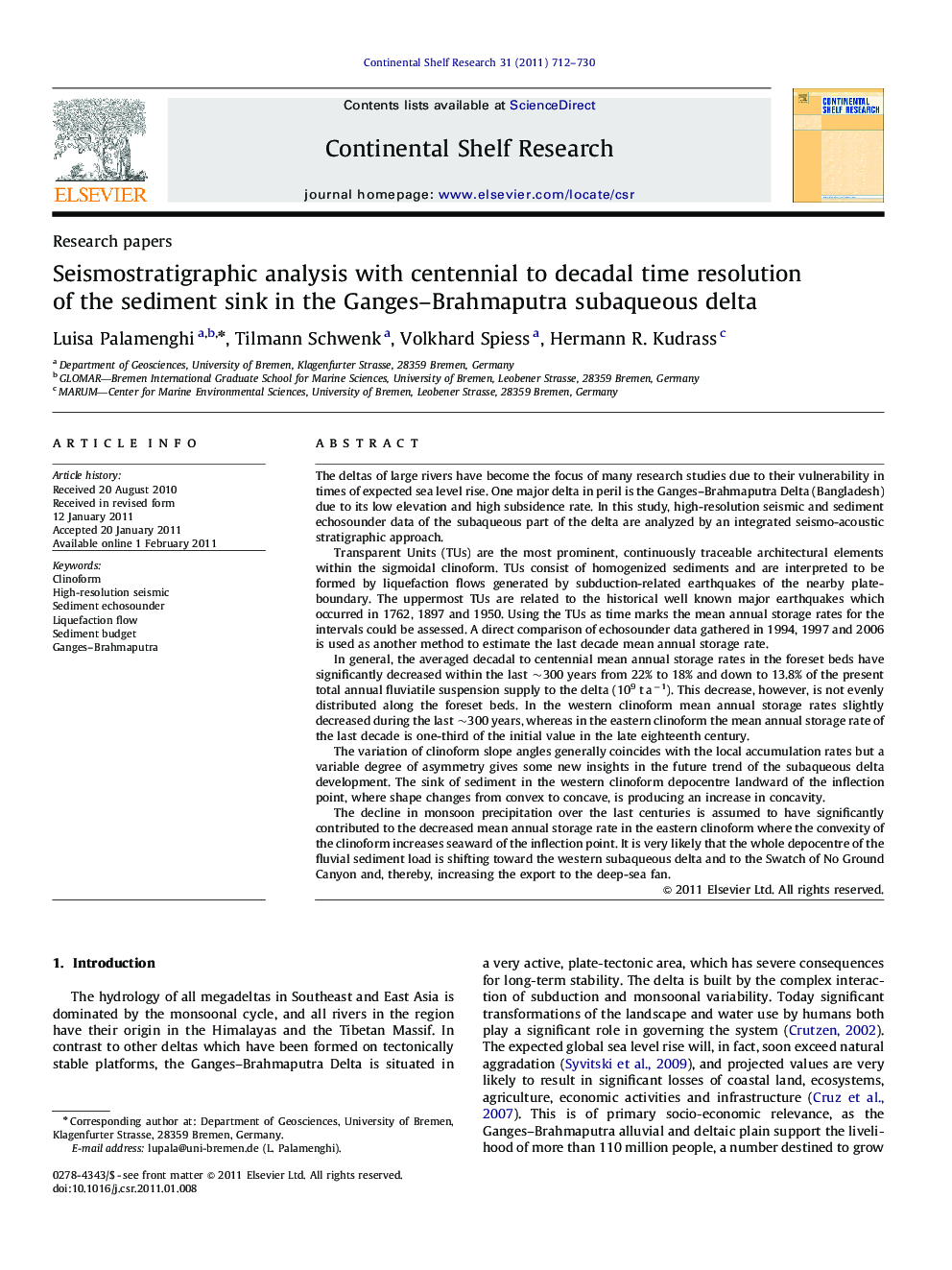| کد مقاله | کد نشریه | سال انتشار | مقاله انگلیسی | نسخه تمام متن |
|---|---|---|---|---|
| 4532673 | 1325139 | 2011 | 19 صفحه PDF | دانلود رایگان |

The deltas of large rivers have become the focus of many research studies due to their vulnerability in times of expected sea level rise. One major delta in peril is the Ganges–Brahmaputra Delta (Bangladesh) due to its low elevation and high subsidence rate. In this study, high-resolution seismic and sediment echosounder data of the subaqueous part of the delta are analyzed by an integrated seismo-acoustic stratigraphic approach.Transparent Units (TUs) are the most prominent, continuously traceable architectural elements within the sigmoidal clinoform. TUs consist of homogenized sediments and are interpreted to be formed by liquefaction flows generated by subduction-related earthquakes of the nearby plate-boundary. The uppermost TUs are related to the historical well known major earthquakes which occurred in 1762, 1897 and 1950. Using the TUs as time marks the mean annual storage rates for the intervals could be assessed. A direct comparison of echosounder data gathered in 1994, 1997 and 2006 is used as another method to estimate the last decade mean annual storage rate.In general, the averaged decadal to centennial mean annual storage rates in the foreset beds have significantly decreased within the last ∼300 years from 22% to 18% and down to 13.8% of the present total annual fluviatile suspension supply to the delta (109 t a−1). This decrease, however, is not evenly distributed along the foreset beds. In the western clinoform mean annual storage rates slightly decreased during the last ∼300 years, whereas in the eastern clinoform the mean annual storage rate of the last decade is one-third of the initial value in the late eighteenth century.The variation of clinoform slope angles generally coincides with the local accumulation rates but a variable degree of asymmetry gives some new insights in the future trend of the subaqueous delta development. The sink of sediment in the western clinoform depocentre landward of the inflection point, where shape changes from convex to concave, is producing an increase in concavity.The decline in monsoon precipitation over the last centuries is assumed to have significantly contributed to the decreased mean annual storage rate in the eastern clinoform where the convexity of the clinoform increases seaward of the inflection point. It is very likely that the whole depocentre of the fluvial sediment load is shifting toward the western subaqueous delta and to the Swatch of No Ground Canyon and, thereby, increasing the export to the deep-sea fan.
Research highlights
► An integrated seismo-acoustic stratigraphic analysis was made of the Ganges–Brahmaputra Subaqueous Delta.
► The uppermost unit is 300 years old and is a sigmoidal clinoform maximum 25 m thick.
► The clinoform recorded 4 major earthquakes of the neighbor subduction zone as liquefaction flows.
► The mean annual storage rate decreased in the last 300 years from 22% to 13.8% of the total fluviatile sediment supply.
► The changing asymmetry of the clinoform surface indicates a shift of the main depocentre towards the west.
Journal: Continental Shelf Research - Volume 31, Issue 6, 15 April 2011, Pages 712–730